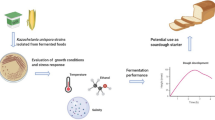Abstract
Baker’s yeast,Saccharomyces cerevisiae, is a key microorganism used in the baking industry. While the preferred substrate for baker’s yeast is generally glucose, the predominant carbohydrate in lean dough is maltose. Therefore, in order to improve the leavening properties of lean dough, it is essential to improve maltose metabolism by the yeast. The objective of this study was to gain better insight into the regulation of the yeast maltose-transporter, maltose permease, and the maltose-cleaving enzyme, maltase, by glucose in lagging and non-lagging strains of baker’s yeast. Gas evolution in a low sugar model liquid dough (LSMLD) medium was used to select five out of ten industrial baker’s yeast strains for further investigation on the basis of varying metabolic characteristics. In all four of the lagging strains tested, both maltose permease and maltase were inhibited by glucose to some extent. In the relative non-lagging strain, which demonstrated the highest performance in LSMLD, it was shown that maltase was not inhibited by glucose. Based on our findings, it indicated that in lean dough leavening, it is the maltase that plays the essential role in maltose metabolism, rather than the maltose permease. Therefore, we propose that the lack of glucose repression on maltase activity is the most critical criterion in the development of non-lagging strains of baker’s yeast.
Similar content being viewed by others
References
Angelov A.I., Karadjov G.I., Roshkova Z.G. (1996). Strains selection of baker’s yeast with improved technological properties. Food Res. Int., 29: 235–239.
Araújo C.A., Pacheco A., Almeida M.J., Martins I.S., Leão C., Sousa M.J. (2007). Sugar utilization patterns and respiro-fermentative metabolism in the baker’s yeastTorulaspora delbrueckii. Microbiology, 153: 898–904.
Bell P.J.L., Higgins V.J., Attfield P.V. (2001). Comparison of fermentative capacities of industrial baking and wild-type yeasts of the speciesSaccharomyces cerevisiae in different sugar media. Lett. Appl. Microbiol., 32: 224–229.
Bradford M.M. (1976). A rapid and sensitive method for the quantitation of microgram quantities of protein utilizing the principle of protein-dye binding. Anal. Biochem., 72: 248–254.
Charron M.J., Dubin R.A., Michels C.A. (1986). Structural and functional analysis of theMAL1 locus ofSaccharomyces cerevisiae. Mol. Cell. Biol., 6: 3891–3899.
Gancedo J.M. (1998). Yeast carbon catabolite repression. Microbiol. Mol. Biol. Rev., 62: 334–361.
Gascón S., Lampen J.O. (1968). Purification of the internal invertase of yeast. J. Biol. Chem., 243: 1573–1577.
Han E.K., Cotty F., Sottas C., Jiang H., Michels C.A. (1995). Characterization ofAGT1 encoding a general alpha-glucoside transporter fromSaccharomyces. Mol. Microbiol., 17: 1093–1107.
Hazell B.W., Attfield P.V. (1999). Enhancement of maltose utilization bySaccharomyces cerevisiae in medium containing fermentable hexoses. J. Ind. Microbiol. Biotech., 22: 627–632.
Higgins V.J., Braidwood M., Bell P., Bissinger P., Dawes I.W., Attfield P.V. (1999a). Genetic evidence that high noninduced maltase and maltose permease activities, governed byMALx3-encoded transcriptional regulators, determine efficiency of gas production by baker’s yeast in unsugared dough. Appl. Environ. Microbiol., 65: 680–685.
Higgins V.J., Braidwood M., Bissinger P., Dawes I.W., Attfield P.V. (1999b). Leu343Phe substitution in the Malx3 protein ofSaccharomyces cerevisiae increases the constitutivity and glucose insensitivity of MAL gene expression. Curr. Genet., 35: 491–498.
Hino A., Mihara K., Nakashima K., Takano H. (1990). Trehalose levels and survival ratio of freeze-tolerant versus freezesensitive yeasts. Appl. Environ. Microbiol., 56: 1386–1391.
Hirasawa R., Yokoigawa K. (2001). Leavening ability of baker’s yeast exposed to hyperosmotic media. FEMS Microbiol. Lett., 194: 159–162.
Hu Z., Yue Y., Jiang H., Zhang B., Sherwood P.W., Michels C.A. (2000). Analysis of the mechanism by which glucose inhibits maltose induction ofMAL gene expression inSaccharomyces. Genetics, 154: 121–132.
Jiang H., Medintz I., Zhang B., Michels C.A. (2000). Metabolic signals trigger glucose-induced inactivation of maltose permease inSaccharomyces. J. Bacteriol., 182: 547–654.
Klein C.J.L., Olsson L., Rønnow B., Mikkelsen J.D., Nielsen J. (1996). Alleviation of glucose repression of maltose metabolism byMIG1 disruption inSaccharomyces cerevisiae. Appl. Environ. Microbiol., 62: 4441–4449.
Novak S., Zechner-Krpan V., Marić V. (2004). Regulation of maltose transport and metabolism inSaccharomyces cerevisiae. Food Tech. Biotechnol., 42: 213–218.
Phaff H.J., Miller M.W., Mrak E.M. (1978). The Life Yeasts, 2nd edn., Harvard University Press, Cambridge, MA.
Rincón A.M., Codón A.C., Castrejón F., Benítez T. (2001). Improved properties of baker’s yeast mutants resistant to 2-deoxy-D-glucose. Appl. Environ. Microbiol., 67: 4279–4285.
Rollini M., Casiraghi E., Pagani M.A., Manzoni M. (2007). Technological performances of commercial yeast strains (Saccharomyces cerevisiae) in different complex dough formulations. Eur. Food Res. Technol., 226: 19–24.
Serrano R. (1977). Energy requirements for maltose transport in yeast. Eur. J. Biochem., 80: 97–102.
Tangney M., Fleming A.B., Jorgensen P.L., Priest F.G. (1998). Regulation of maltose metabolism in stationary phase cultures of an asporogenous mutant ofBacillus licheniformis. J. Appl. Microbiol., 84: 201–206.
Verstrepen K.J., Iserentant D., Malcorps P., Derdelinckx G., Dijck P.V., Winderickx J., Pretorius I.S., Thevelein J.M., Delvaux F.R. (2004). Glucose and sucrose: hazardous fast-food for industrial yeast? Trends Biotechnol., 22: 531–537.
Wang X., Bali M., Medintz I., Michels C.A. (2002). Intracellular maltose is sufficient to inducedMAL gene expression inSaccharomyces cerevisiae. Eukaryot. Cell, 1: 696–703.
Author information
Authors and Affiliations
Corresponding author
Rights and permissions
About this article
Cite this article
Jiang, T., Xiao, D. & Gao, Q. Characterisation of maltose metabolism in lean dough by lagging and non-lagging baker’s yeast strains. Ann. Microbiol. 58, 655–660 (2008). https://doi.org/10.1007/BF03175571
Received:
Accepted:
Issue Date:
DOI: https://doi.org/10.1007/BF03175571




